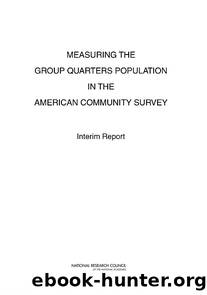Measuring the Group Quarters Population in the American Community Survey: Interim Report by National Research Council of the National Academies

Author:National Research Council of the National Academies
Language: eng
Format: epub
Tags: Behavioral and Social Sciences : Population and Fertility Studies
Publisher: NATIONAL ACADEMIES PRESS
Published: 2010-12-29T00:00:00+00:00
SAMPLE REDESIGN OPTIONS
An overall question to consider is whether the sampling designâwhich relies on two separate samples, one for housing units and one for group quartersâis efficient in the case of every GQ type. In addition to the issue of duplication between the two frames, some of the living quarters move back and forth between them. For example, as mentioned earlier, some group quarters are converted to housing units, then back to group quarters, in the course of relatively short periods of time. Currently, if a group quarter is converted to a housing unit or if a housing unit turns out to be group quarter, the case is closed out and an interview is not completed. Greater field efficiencies might be derived with alternative procedures.
Small group quarters are disproportionately more likely to be converted to housing units by the time a field representative visits the premises than larger facilities, and some GQ types, such as homeless shelters and juvenile detention centers, are also more susceptible to this type of change (Williams, 2010). The Census Bureau should evaluate whether redesigning the sample based on either GQ size or type would improve the efficiency of the data collection. As discussed in Chapter 3, small and large group quarters are not sampled the same way, which raises the question of whether it would also be worthwhile to continue research on whether a cutpoint other than 15 or fewer for the expected number of residents would be more efficient for defining âsmallâ facilities. A model relating an indicator of being in scope to the measure of size may be helpful in this regard.
Possibilities for redesigning the sample would include dropping small group quarters (or certain types of them) from the GQ sample or adjusting the data collection procedures to make it possible to interview residents of these facilities as part of the household data collection. In the latter case, for these living quarters, a determination about whether they are a household or a GQ facility would be made only during the interview rather than in advance. Naturally, this approach is more appropriate for the noninstitutional group quarters, and field representatives would not encounter some types at all while working a primarily household sample. For example, they would be unlikely to come across a large correctional facility. Integrating these two data collection efforts would be a substantial undertaking, and the subsampling procedures would have to be applied on the fly while the facility interviews are in progress. Nevertheless, there could be cost savings if the process involving these cases could be simplified. The Census Bureau could retain the goal of covering virtually the entire U.S. population without having to maintain a sampling frame for some of the difficult-to-cover sizes of group quarters. It is also possible that this approach would improve the household coverage rate.
An alternative option would be to drop certain types of group quarters (e.g., homeless shelters) from direct sampling instead of dropping group quarters of a certain size. Given that changes in GQ size are likely to be more frequent than type changes, this design may be more practical.
Download
This site does not store any files on its server. We only index and link to content provided by other sites. Please contact the content providers to delete copyright contents if any and email us, we'll remove relevant links or contents immediately.
Modelling of Convective Heat and Mass Transfer in Rotating Flows by Igor V. Shevchuk(6391)
Weapons of Math Destruction by Cathy O'Neil(6146)
Factfulness: Ten Reasons We're Wrong About the World – and Why Things Are Better Than You Think by Hans Rosling(4694)
Descartes' Error by Antonio Damasio(3230)
A Mind For Numbers: How to Excel at Math and Science (Even If You Flunked Algebra) by Barbara Oakley(3221)
Factfulness_Ten Reasons We're Wrong About the World_and Why Things Are Better Than You Think by Hans Rosling(3199)
TCP IP by Todd Lammle(3134)
Fooled by Randomness: The Hidden Role of Chance in Life and in the Markets by Nassim Nicholas Taleb(3044)
Applied Predictive Modeling by Max Kuhn & Kjell Johnson(3018)
The Tyranny of Metrics by Jerry Z. Muller(3000)
The Book of Numbers by Peter Bentley(2912)
The Great Unknown by Marcus du Sautoy(2648)
Once Upon an Algorithm by Martin Erwig(2599)
Easy Algebra Step-by-Step by Sandra Luna McCune(2585)
Lady Luck by Kristen Ashley(2534)
Practical Guide To Principal Component Methods in R (Multivariate Analysis Book 2) by Alboukadel Kassambara(2497)
Police Exams Prep 2018-2019 by Kaplan Test Prep(2487)
All Things Reconsidered by Bill Thompson III(2357)
Linear Time-Invariant Systems, Behaviors and Modules by Ulrich Oberst & Martin Scheicher & Ingrid Scheicher(2334)
